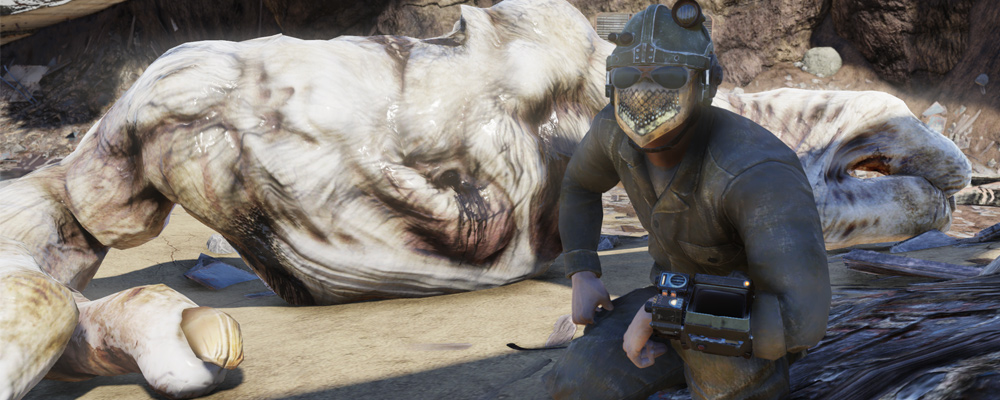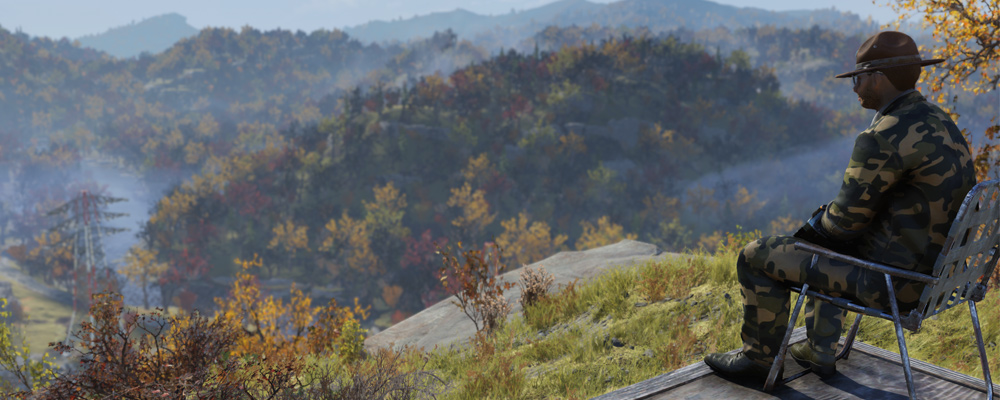3 things in Fallout 76 that are pretty great
Being a Mothman geek, visiting Point Pleasant was rather enjoyable
Everyone hates Fallout 76. In between Metacritic review bombings and angry rants from well known gaming personalities sits a fairly unimpressed Bethesda audience. Despite all this, there are definitely some aspects of Fallout 76 that that are dramatic improvements to the franchise’s gameplay and are a sorely needed update to the previous games biggest issues. Fallout 4 absolutely knocked it out of the park in regards to an expansive story and unique map, but it lacked the real-world survival components that made the earliest games so intriguing.
In all, Fallout 76 seems to have attempted to bridge the gap between real-world post apocalyptic survival and the deep and meaningful narrative elements that made up Fallout 4 and its DLC’s. But while it’s easy to dump on the latest game in the series, there are three improvements that make it stand out in comparison to its predecessors:
Caps are actually useful now
Posing after bagging my first Grafton monster
One of my biggest pet peeves in Fallout 4 was the redundancy of trade after you reach higher levels; after 30 or 40 hours prowling through the wastelands of The Commonwealth you’ve normally collected more ammo than the United States military industrial complex, you’ve scrounged the highest armor and weapons you can possibly find from the corpses of your defeated foes and you are carting around enough caps to start your own refreshment company. At this point the trading system effectively becomes pointless. You may end up checking a vendor now and then to search for unique weapons, but why would I spend 2,000 caps on a ‘Mantis’ leather right arm when I can go out and zap a few legendary creatures and get something infinitely better for free? Who here has used a meat or chem vendor? I put over 300 hours into Fallout 4 and never used them once. Why would I when it seems like you can’t walk through a building anywhere in Boston without tripping over Stimpacks, Psycho or Buffout.
I’m also going to hazard a guess and say you’ve probably never purchased anything from one of the many vendors you set up in your settlements, or even bothered to collect the caps they deposit in your workshop. That’s because by the time you’re high level enough to begin building them the concept of trade is absolutely pointless.
Fallout 76 addresses this issue by making caps both sparse and necessary for common interactions like fast travel or moving your C.A.M.P. On the surface it may seem like making people spend caps to fast travel is insidious, but it means you can no longer zip around the map like a Spanish conquistador on meth. If you’re broke you’ll be forced to hoof it like regular folk, forcing you to consume food, water and fight your way through enemies to get to where you need to be. Oh and trust me, you’ll be broke at many points during the game – Fallout 76’s new C.A.M.P system means that you need to acquire schematics (or plans are they’re called in the game) to begin building armor, weapons and add-ons for your buildings. Most of these schematics you’ll scrounge from the ruins of West Virginia, but higher level plans require you to, yes, buy them from the various vendors either stationed at train stations, Responder camps or from travelling peddlers wandering around the wastes. With the scarcity of caps and the high costs to buy higher-level plans (low level plans range at around 90 caps, the highest at around 1200), I’ve been finding myself taking trips around the countryside with the express purpose of acquiring funds, because without plans you simply won’t survive the eastern side of the map.
The necessity for caps also means both junk and chems are highly prized items to sell, while simultaneously being highly prized items to keep. Many times throughout my journey I’ve been forced to weigh up the benefits of selling items I’ve scrounged from ruins with a more direct need for me to keep as much scrap as I can to fix my ailing gear. 76 obliges you to regularly weigh up the needs of the present with the needs of future you; “I can either scrap this glow-sighted combat shotgun because I need the metal, I can sell it for caps and save towards a schematic that allows me to build my own at anytime, or I can use it in combat right now because it’s drastically better than my current shotgun.” These are decisions you never had to make in Fallout 3 or 4 upon reaching a moderate level and it adds to the real-world survival components that Bethesda was likely aiming for.
Storage is limited so you better lean to specialize
“Oh, hello, I didn’t see you there…..”
Like a doofus my first instinct while playing 76 was to immediately put myself in a Fallout 4 mindset, picking up every single piece of ammo and scrap I could lay my hands on. By level 10 I was carrying around close to 2,000 rounds of .308 rifle ammunition and I had become a literal walking gun vendor. 76’s big improvement (some won’t call it that) is that ammunition now has weight. In fact, everything has weight, even some scraps of paper. To compile the issue, storage in workshops and your C.A.M.P differs drastically from Fallout 4: your camp ‘workshop’ storage is limited to 400, building additional storage won’t increase that number and things like chests, drawers and dressers no longer operate as independent storage containers. Gone are the days of piling 40 guns into a bedside table or fitting 72 pieces of armor into a set of shelves.
On the surface this may seem like something to grumble about, but harking back to the real-world survival element of the game it forces the player to specialize and make drastic decisions. The limited storage capacity means players need to weigh up the usefulness of weapons and armor; “Having a missile launcher is great, but it weighs 20, that’s 20 slots in my workshop storage I don’t have and it means carrying less guns, equipping lighter crappier armor and picking up less junk.”
For this reason 76 makes you do things you don’t really want to do, especially early on in the game – you’ve gotta scrap some great large weapons. I personally (and through many tears) had to say goodbye to a Minigun, a harpoon gun, a missile launcher and a .50 cal machine gun. Bigger guns also mean bigger ammo, with the missile launcher being another prime example of the hazards of picking ammunition up off the ground willy nilly. Missiles weigh 3 slots each, yes you heard me, 3. Not the launcher. Each. Individual. Missile.
So how to you get them back after you scrap them? You can’t just rank up and automatically acquire them at your weapons bench anymore, going back to the first point in this article you either have to fight for them again, scavenge plans to build them or buy schematics from vendors or other players.
The upside of this means you have to specialize – you either head into combat with few large weapons and perhaps a smaller sidearm, carrying a variety of smaller rifles or stripped back entirely as a close combat specialist with unique knives and melee weapons. The result is that I’ve found myself using weapons in 76 that I never used at all effectively in Fallout 3 or 4, like the Power Fist or Automatic Pipe-Pistol.
The specialization extends beyond combat too. By foraging less weapons, armor and ammunition you’re left with more storage slots to either store or scavenge junk to repair your gear or craft new C.A.M.P items.
The result in all this is that more than ever living in the post apocalyptic remnants of West Virginia makes me feels like I’m a true wastelander.
The map is gorgeous. And massive
West Virginia: come for the views, stay for the irradiated monstrosities
Fallout’s 1 – 4 and New Vegas were incredibly dreary, but rightfully so. Taking place in cities and areas hit directly by the bombs of the ’77 war it’s natural to assume those landscapes became barren irradiated hellzones.
76 however takes a different approach and puts the player in West Virginia, an isolated state that we can assume doesn’t take a direct hit from a nuclear weapon. Because of this anomaly large sections of the map are actually green and bursting with life. Strolling through the western portions of the map, affectionately called ‘The Forest’, you stumble upon farms and towns still teeming with robot workers doing chores, herds of Brahmin munching in fields and untouched forests filled with fruits, berries and flowers. The western side of the map is also where you’ll find the largest population center’s like Charleston, Point Pleasant, Flatwoods and Grafton. With larger populations come all the trappings that go along with it – universities, department stores, hospitals and emergency services.
It’s a genuinely surreal Fallout experience.
Moving south you move into the industrial areas of West Virginia, dotted with burning coal mines, struggling mining towns and dilapidated industrial workshops filled with expensive gear, but guarded by hardened enemies.
Nestled in the middle of the map are huge hillsides, ski resorts , leisure centers and popular attractions. The variety is absolutely mind bending. To date I can’t tell you what lies further east of the mountains because after nearly two straight weeks of playing I’m yet to travel there. By appearances it seems like an area comparable in size and variety as the parts of the map I’ve already explored.
To take in the scenery, I made my camp not far from Point Pleasant, on the top of a small mountain overlooking the Ohio River. Sometimes I like to sit on the deck of my modest two story wooden home beside the campfire I built and watch the serene nature of the map pass by. It’s particularly pleasing early morning.
Despite everything I’ve mentioned above there are definitely still some aspects of Fallout 76 that are unforseen hindrances to players and more than just annoying quirks. For balance I’ll be devoting another article entirely to those negative issues, but as a teaser it feels as though the multiplayer aspect of the game really isn’t being utilized effectively enough. Particularly around bounties, trade and griefers.
However, while I may agree that the current bugs are making the game unplayable at times, in all I’m genuinely enjoying my Fallout 76 experience. The balance between survivalist and warrior works more effectively than in any game prior and I’m being critically challenged by the enemies the world is throwing at me. At level 45 I’m finding that firefights are more than just charging headfirst into a slew of Super Mutants and knowing I’ll be walking out unscathed. More than ever players are forced to make the most of suppressors, mines or just avoiding combat altogether. I’ve turned tail and run like a frightened weasel from more Scorchbeasts than I can count.
Between the badly needed update to economy, the real-world weight limits and the beautiful and expansive map, Fallout 76 is has made some great improvements on previous fallout titles.
And honestly, these are things that would be welcome additions in future games of the series.
- Andrew Archer





